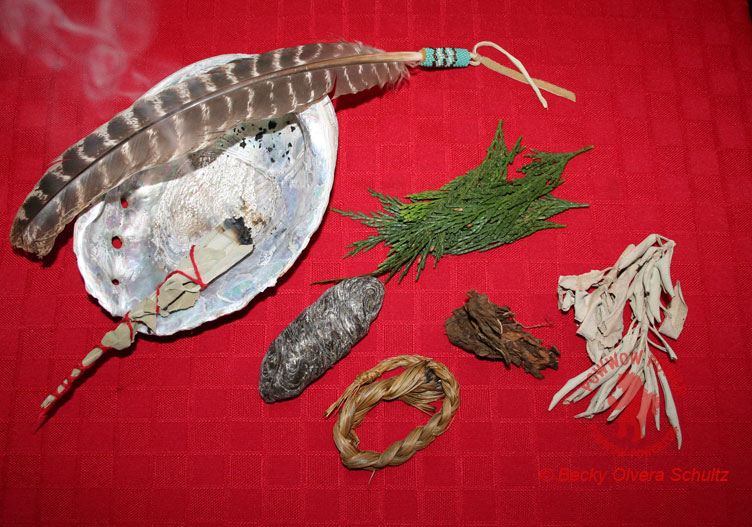Smudging Ceremony
The smudging ceremony is a custom of Native American and other indigenous cultures. For centuries many cultures have used smudging as a way to create a cleansing smoke bath that is used to purify the body, aura, energy, ceremonial/ritual space or any other space and personal articles. Smudging is performed to remove negative energy as well as for centering and healing. Our bodies and environments are not only physical but vibrate with invisible, silent energy.
Smudging calls on the spirits of sacred plants to drive away negative energies and restore balance. Plants such as tobacco, sage, cedar, sweet grass, juniper, lavender and copal are burned and the smoke is directed with a single feather or a fan made of several feathers. Sage is said to purify and drive out negative energy, sweet grass to attract positive energy, beauty and sweetness, cedar to ward off sickness, lavender to bring spiritual blessing. Many tribes consider tobacco to be the most sacred plant, chasing away bad or negative feelings and bringing on good and positive thoughts and to connect people with the spiritual world. Native peoples used tobacco as a medicine, smoked in the evenings and not as a daily occurrence. Tobacco can become a poison when abused and treated without proper respect.
A single plant or mixture of plants is placed in a shell or other fireproof bowl and lit. Some cultures use only shells such as abalone, believing the shell, an element of water, balances the other elements of fire, air, and earth (plants) while some cultures will not use shells believing that the water element of the shell nullifies the fire element of the smudging. The dried plants are lit and aided in burning by waving a feather, fan or hand. Blowing on the mixture is not advised as it is seen as blowing ones negativity into the mixture as well as blowing away the effectiveness of the plant. The smoke is than wafted around oneself and environment creating a bath of smoke.
Dried plants that are tied into bundles are called smudge sticks, which are lit and burned on one end. Loose plants can be burned in the shell or bowl or placed directly onto burning wood or crumbled over a piece of charcoal.
In native cultures birds are highly revered because of their closeness to Grandfather Creator in the heavens. It is believed the feather possesses the spirit qualities of the bird– to be the breath of life as well as connecting us to the heavens above and mother earth below. Because of the way they are constructed, it is believed that feathers have the ability to comb someones energy or aura of blockages therefore aiding in the cleansing smoke bath.
Ceremonial & dance fans are made by Native Americans from all or part of a wing of an eagle. Some indigenous peoples may use other raptor or exotic bird feathers. Southwestern, Central and South American tribes often use macaw feathers, especially for prayer fans.
Remember that smudging is for cleansing your body and environment, not to fill the room or your lungs with smoke! Avoid smudging where there are allergic people, infants or pregnant women.
Dont leave bowls, smudge sticks, candles, charcoal or other items used for smudging unattended. Usually the plants in the container or the smudge sticks will burn out on their own. If you need to distinguish them, tap the end of the smudge sticks or sweet grass braids on the container until burned out, or keep a little sand or soil in the bowl or shell to snuff them out with and to keep the bottom of the container from getting too hot.



